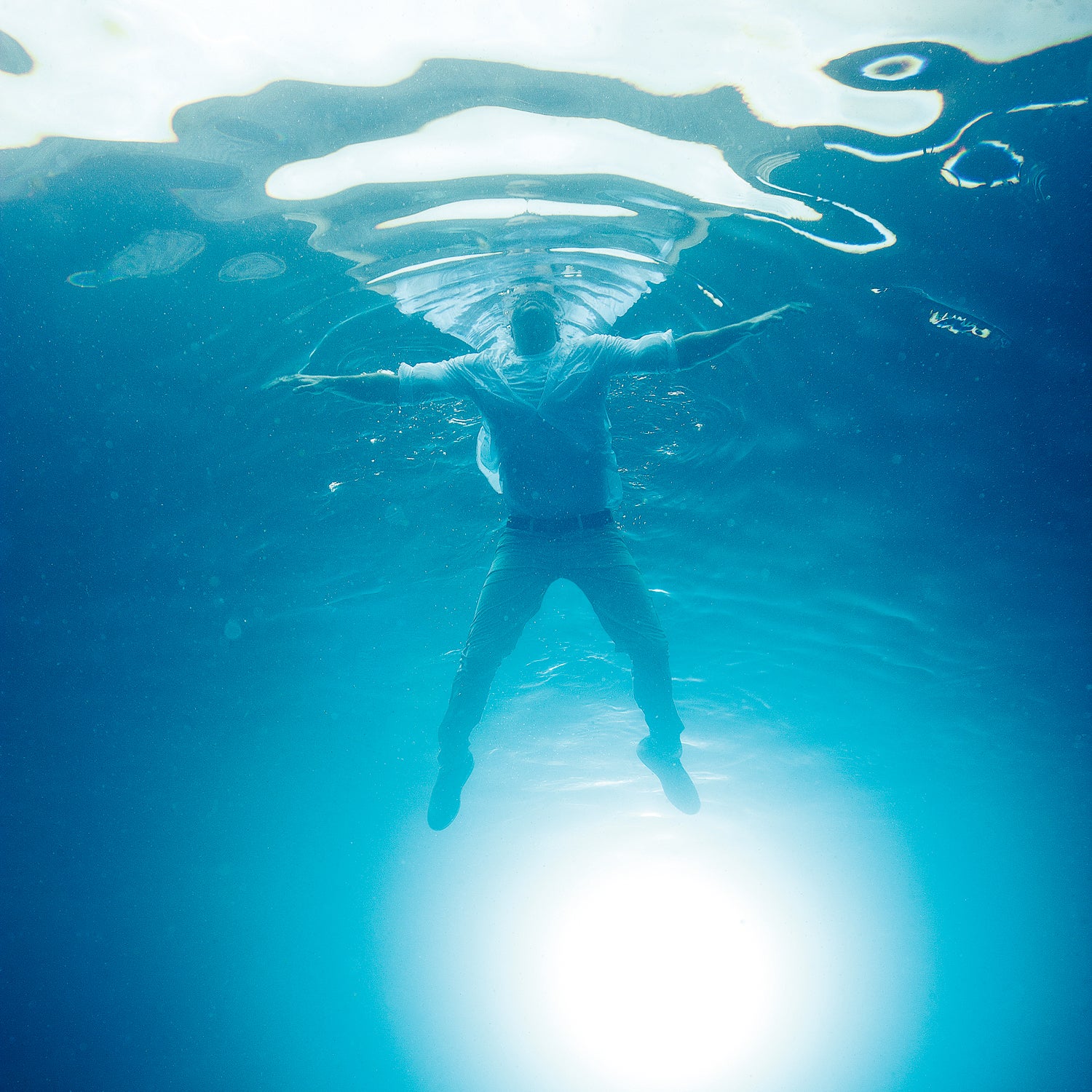It's the end of the world as we know it. Not really, but given the recent surge in natural disasters, it sure seems that way. Here's how to deal with ten deadly scenarios. Plus: firsthand accounts from the disasters in Joplin, Missouri, Texas, Libya, and Japan.
Earthquake!
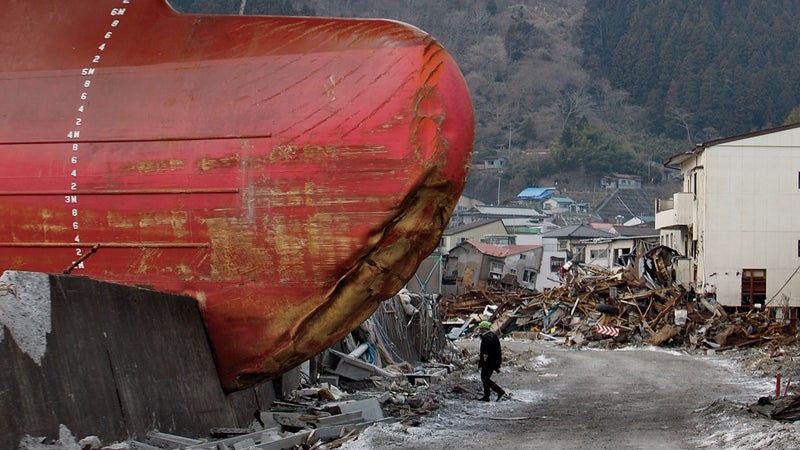
The Forecast: An 8.8 in Chile, an 8.0 in Sichaun, China, 7.0 in Haiti, 9.0 in Japan—if the past three years are any indication, it certainly appears as though quakes are on the rise. But according to the U.S. Geological Survey, it's just that we've had more activity in unprepared or heavily populated areas. Where next? Domestic sites considered overdue for a shaker include St. Louis, Alaska, and the Pacific Northwest.
Stats: 5,800—the number of fatalities that could occur, according to the USGS, if a 7.9 quake were to hit the San Andreas Fault, two miles from San Francisco.
Worst-case scenario: Trapped in debris. The natural reaction is to scream for help and struggle to escape—don't. Shouting could cause you to inhale toxins; sudden movement might displace large objects onto you. Cover your mouth with clothing to block dust and knock on something to alert rescuers.
Smart Play: Before you travel to an earthquake-prone region, register with the government's ��so Uncle Sam knows your whereabouts. If you're in an urban area when a quake hits, get inside a building—but avoid unreinforced-concrete structures.
Plague!
The Forecast: Not since 1918, when the Spanish flu killed between 50 million and 100 million people worldwide, has an airborne or contact scourge effectively culled the human race. But in the past decade, SARS, monkeypox, and avian flu have all forced epidemiologists to work overtime. Last year, experts reported that the H1N1 “swine flu,” a certified pandemic, killed 14,000 people. The U.S. government's regional stockpiles of antibiotics and vaccines for various strains of flu now account for H1N1.
Stats: 40,000—droplets per sneeze, which can stay suspended in the air for hours. 36,000—average number of U.S. deaths each year from the flu.
Worst-case scenario: A flu pandemic without a vaccine. If one strikes, be vigilant about hygiene: keep clean and avoid coughers.
Smart Play: While survivalists stock up on Cipro and Tamiflu, Thomas Kirsch, an M.D. at Johns Hopkins and a member of the Red Cross Scientific Advisory Council, suggests simple alcohol-based hand sanitizer. “In a true pandemic, I'd wash my hands 100 times a day,” says Kirsch.
More Likely Scenario: Dysentery
What: A form of diarrhea mixed with blood and mucus caused by either an amoeba or a bacterial infection. Although it's rare in the developed world, the literally gut-wrenching infection hits about 120 million people per year and is a common ailment among international travelers.
Strategy: Oral rehydration salts (we like , $9) are the first course of action after infection, but if the bug doesn't pass, get to a clinic for a saline drip and antibiotics.
Tornado!
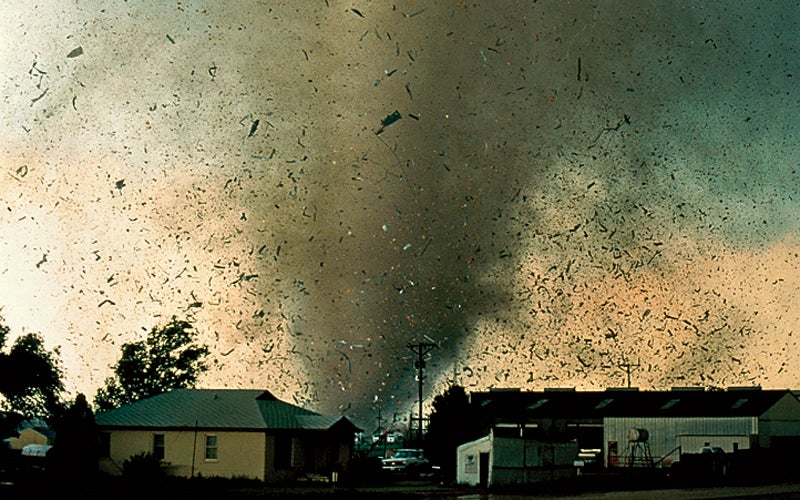
The Forecast:��In April 2011, the epicenter of activity shifted from Tornado Alley to the mid-South, where 875 tornadoes killed 336 people across six states and a 1.5-mile-wide funnel hit Tuscaloosa, Alabama. It was the busiest month for twisters in U.S. history. Then, in May 2011, a tornado in Joplin, Missouri, killed more than 140 people. The likely culprit? The tail end of La��Niña, a cooling of the Pacific Ocean that redirects the jet stream over the U.S. Since then, 2012 and 2013 have seen generally quieter seasons.
Stats:��69—total 2012 tornado deaths in the U.S. Compare to 525 deaths in 2011 and 794 deaths in 1925, the deadliest reported year in U.S. history.
Worst-case scenario:��Being caught outside. Seek shelter, preferably underground. If you're on foot or riding a bike and can't make it to shelter, get as low as possible—look for a ditch—and cover your head.��
Smart Play:��Wear a helmet. “People die by getting hit in the head with debris,” says Harold Brooks, a research meteorologist at the National Severe Storms Laboratory in Norman, Oklahoma. “We recommend a helmet even if you're in a basement.”
Meltdown!
The Forecast:��About three million Americans live within a ten-mile radius of one of the nation's 104 operating nuclear power plants. While the U.S. has never had a full-blown meltdown, there have been half a dozen close calls. And the problems at the Fukushima��Daiichi��plant in Japan following the March earthquake have experts like David��Lochbaum, chief nuclear watchdog at the Union of Concerned Scientists, spooked—especially since 23 American plants share the same venting and cooling designs as Fukushima.
Stats:��100—the U.S. legal limit of��millirems��(units of radiation exposure) nuclear-power plants can expose the public to each year. 2,000—the projected number of��millirems��within an 18-mile radius of Fukushima��Daiichi��one year after the accident. 24—miles the 38-year-old Indian Point power plant sits from Manhattan.
Worst-Case Scenario:��Stuck inside the ten-mile emergency zone during a meltdown. If you're forced to wait out a nuclear accident, close all vents and head to the basement. If you think you've been contaminated, strip, put your clothes in a plastic bag outside, shower, and call authorities.
Smart Play:��Run. Radiation exposure decreases drastically the farther you get from the source. Moving even a few miles away can significantly reduce your exposure. Once you're more than 50 miles from a meltdown, you're probably safe.
More Likely Scenario:��Chemical Spill��
What:��Leaks from flipped tanker trucks or accidents at processing plants or on oil rigs. According to the National Response Center, there were more than 30,000 chemical and biological incidents in 2010.
Strategy:��Get to the highest floor you can to avoid fumes. Turn off all fans, heaters, and air conditioning. Seal all doors and windows tightly with duct tape.
Volcano!
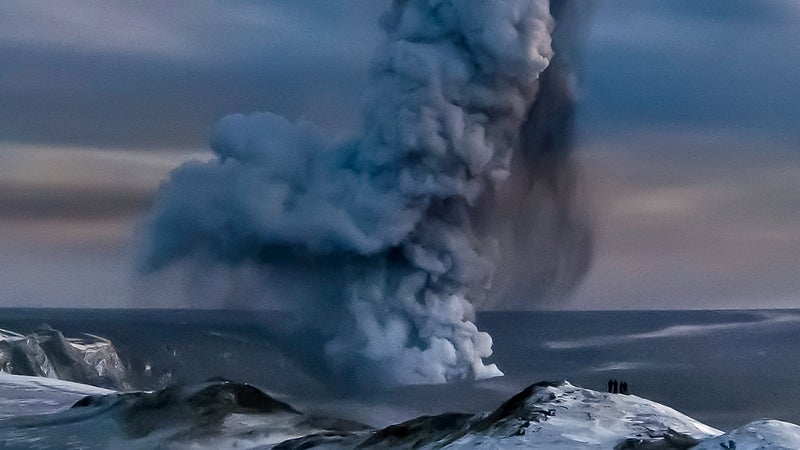
The Forecast: Each year, about 60 of the world’s 1,500 potentially active volcanoes blow. Most produce only a weak sputter, but occasionally a peak goes big: Iceland’s Eyjafjallajökull halted air travel in Europe for six days last year with its six-mile-high ash plume. Domestically, scientists fear that magma movements below Mount Rainier could unleash mudslides on Seattle’s suburbs.
Stats: 169—the number of active U.S. volcanoes.
Worst-Case Scenario: Being anywhere near an eruption is obviously bad, but the extended zone of the ashfall can be just as deadly. Goggles, masks, and long sleeves are a must. Ash also needs to be cleared off structures as soon as it’s safe—roof collapse caused by saturated ash is the most common killer in eruptions.
The Smart Play: Going hiking near a volcano? Listen to your guide. In much of the world, experts aren’t equipped to predict volcanic activity, so researchers like Robert Buchwaldt from MIT are teaching locals to identify natural eruption cues. Examples? “Swelling in certain portions of the volcano, big cracks forming, and plants around the volcano drying up.”
Fire!
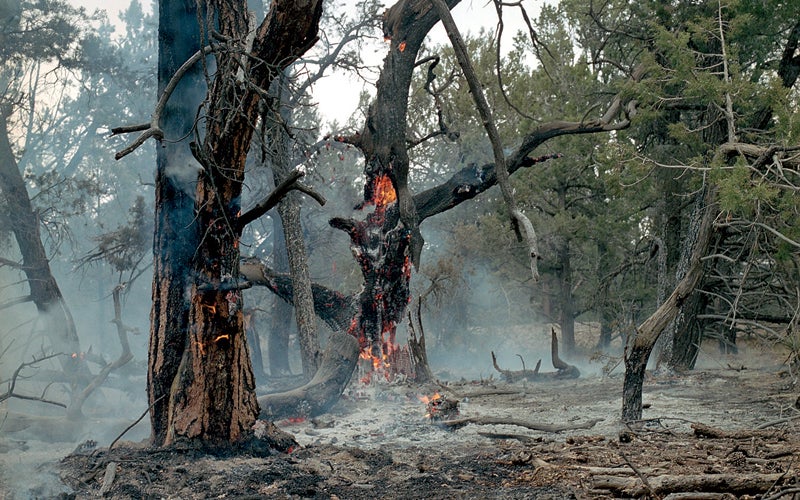
The Forecast: In April, Texas was engulfed with wildfires that eventually consumed more than two million acres and destroyed more than 460 homes. Then, in June, eastern Arizona went up in flames, in the second-largest blaze in state history. Anomalies? Probably not. A 2009 study in the journal Geophysical Research predicts that fire frequency could increase by 50 percent in the next 40 years, mainly due to climate change. Cyclical patterns like El Niño and La Niña also have an impact—this year's La Niña-fueled drought in the Southwest made the area tinder-dry.��
Stats: $3.4 billion—the amount appropriated last year to fight domestic wildfires. $200 million—property damage in Texas this April.
Worst-Case Scenario: You've got no fireproofed shelter. If it happens, don't flee—you can't outrun a fire. Instead, wrap a wet handkerchief around your face and lie prone in a pond or a rocky area. If that's not available, use a match or lighter to burn off a few hundred square feet of brush to create a safe zone. Not enough time for that? If the wall of flames is less than four feet when the fire approaches, you can try jumping across to the burned-out side of the fire. Don't have the nerve? Lie facedown with your mouth as close to the ground as possible and cover yourself with a wet, nonsynthetic material, like a wool blanket.
Smart Play: Consider a portable fire shelter. These once controversial devices have been redesigned and are now often used by wilderness firefighters. Be sure to get one with three-ply fiberglass and aluminum laminate, like those sold by ($323).
More Likely Scenario: Camp Fire
What: Your camp stove explodes.
Strategy: The reflex is to knock it away. Don't—kicking it toward needles and brush will start a rager. Instead, smother a growing fire with water, rubber mats, nonsynthetic clothing, or shovelfuls of dirt. If it jumps into the canopy, evacuate and call Smokey.
Tsunami!
The Forecast:��Tsunamis don't happen on their own—they're triggered by earthquakes, underwater landslides, even meteor impacts. But once triggered, the waves, which can range from ten to more than a thousand feet high, strike without warning. Typically, there are one or two localized tsunamis each year and one monster, like the March wave that devastated Japan's northeast coast. In the U.S., the West Coast, Hawaii, and Alaska are at highest risk due to seismic activity in the Pacific Ocean's Ring of Fire, which produces nearly 90 percent of the world's earthquakes.
Stats:��1,740—height, in feet, of the tallest tsunami ever recorded, in��Lituya��Bay, Alaska, in 1958.����
Worst-Case Scenario:��Being caught off-guard on the beach. Ideally, sensors deployed in the ocean trigger sirens and warning systems that give communities enough notice to leave the coast. But in many parts of the world, you have to look to nature. A tide going out or coming in at an unusual hour is a sure sign of a tsunami. Get to the upper floor or roof of a sturdy building, climb a tree, or, as a last-ditch effort, hold on to a life jacket, cooler, or other buoyant object. Remember: tsunamis can last ten hours, and the first wave isn't always the worst.
Smart Play:��If you're on the water in a kayak, sailboat, or motorboat before a tsunami hits, get as far out to sea as you can. You'll still be lifted by the swell, but if you're in deep enough water, you won't be pushed ashore.
Flood!!
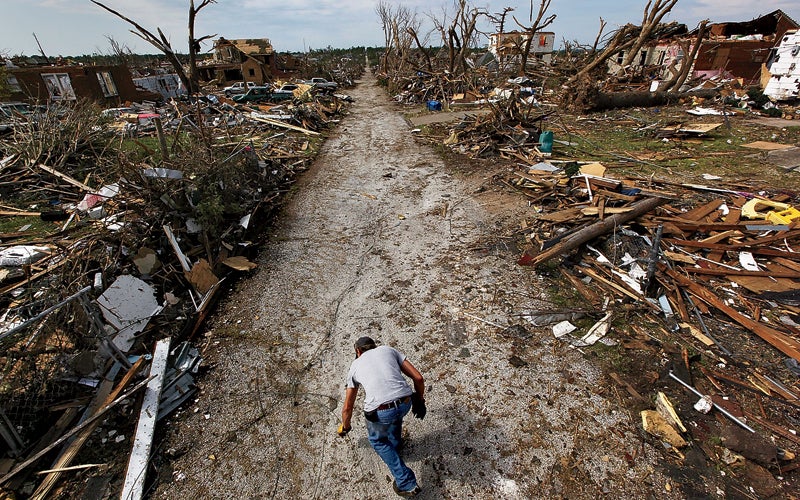
The Forecast:��This year, all eyes are on the Mississippi, which flooded in April. But before that came vicious floods in Australia in January, Pakistan last July, and Nashville last May. Don't expect it to stop: rainfall increased roughly 5 percent over the past 50 years in the U.S., and as the planet warms, climate experts predict more precipitation in already flood-prone tropical countries such as Bangladesh. Urban expansion and increased channeling of rivers have also created a recipe for floods. FEMA is already expanding floodplain maps to include new areas that could be inundated, such as Southern California and San Antonio, Texas.����
Stats:��3.6 million—acres of farmland in Arkansas, Illinois, Louisiana, Mississippi, Missouri, and Tennessee swamped by the April Mississippi River flood.
Worst-Case Scenario:��Being trapped by floodwaters. Even six inches of moving water can knock you off your feet; 24 inches can float an SUV. Staying put and waiting for rescue in a safe area, such as a roof or the upper stories of a sturdy house, is the only strategy.
Smart Move:��In the wilderness, avoid flash floods, which can rip down canyons and streams in an instant. If a clear stream suddenly becomes muddy, begins carrying debris, or starts rising, a flood is coming. If you hear thunder upstream, move to higher ground.
More Likely Scenario:��Class V dump��
What:��Your raft or kayak flipped.
Strategy:��Assume the whitewater swim position—feet aimed downstream, toes above water, head back. If you get caught in a recirculating hole, don't fight to stay on top—let the current submerge and then flush you out. If you go over any drops, tuck your knees under your arms.
Hurricane!
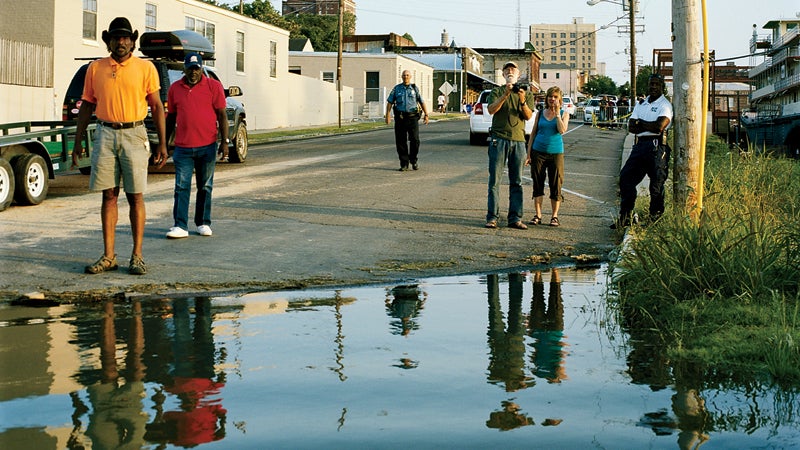
The Forecast: After the brutal storms of the mid-aughts—Katrina, Rita, and Ivan—several mild seasons have bumped hurricanes from the national disaster radar. But that's just a hiatus caused by ocean-current cycles and El Niño. Research from MIT has shown that, since 1995, Atlantic storms have gotten bigger and more frequent. Experts at NOAA's Climate Prediction Center expect the end of La Niña to spin out at least eight major hurricanes.
Stats: 1—number of months hurricane season has increased over the past century, according to Jay Gulledge, director of the Science and Impacts program at the Pew Center on Global Climate Change.��
Worst-Case Scenario: Getting caught in a storm unprepared. If you live in a hot zone, retrofit your garage doors with braces, put bolts on exterior doors, and trim trees so branches won't crash down on your house. When a storm approaches, use plywood or hurricane shutters on windows and place sandbags around low-lying areas. Then leave town.
Smart move: Keep a survival kit with food, water, cash, batteries, and a radio in a sturdy room in case you can't get out of Dodge in time.
Civil Unrest!
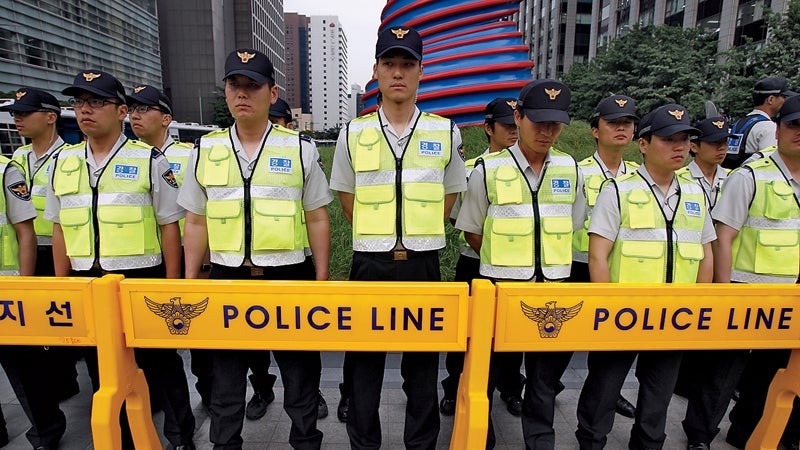
The Forecast: Keeping on top of all the uprisings around the world is a full-time job (see: Cooper, Anderson). Though the Arab Spring grabbed all the headlines, unrest pops up everywhere. In the past year, Jamaica, Thailand, the Ivory Coast, and even the United Kingdom have seen riots.
Stats: 2,300—the number of U.S. citizens evacuated from Egypt last January. 73—the number of people killed during the 2010 Jamaica riots.
Worst-Case Scenario: Being caught in a violent protest. According to AKE, a British security firm that trains CNN's foreign correspondents, if you're suddenly engulfed in a crowd, don't stand there gaping—run away from the incident until you can find a side road, hotel, or police station. The best strategy for dealing with civil unrest is situational awareness: before entering a country or city, you should know the political landscape and whether the authorities are trustworthy. Memorize the location of a reputable medical facility and the U.S. consulate. Keep a photocopy of your passport in a safe place in case you lose your documents, and know your way to the airport or nearest border crossing if things get truly hairy.
Smart Play: A heavy leather jacket is stylish protection against rocks and other projectiles. A polyethylene baseball cap insert, like the ($6.20), turns your lucky Orioles hat into a discreet helmet.
How I Survived
Personal Tales of Narrow Escapes
The Texas Wildfires: Mark Thomas, 48, Amarillo
“When the fireman told me to evacuate, I didn't. Instead, I raced to my house, and the fire was already almost to my fence. I dropped the blade on my tractor and tried to cut a firebreak. But it was too close, so my apprentice and I grabbed a hose, and soon flames were coming up around us. The smoke and heat were burning us, and we couldn't see each other. That was when I finally realized we had to go. I took off toward town going about 60 miles per hour, totally blind because the smoke was so thick. When I finally emerged from the smoke, I saw the fire jump the road. So I turned around and went back to protect my house. It was so hot that pine trees that weren't anywhere near anything burning just kind of exploded. It was one weird thing after another. I was able to save my house but not my neighbors'. It probably wasn't the safest thing to do, but I couldn't help myself. I was raised in the country, and neighbors help neighbors.”��—As told to K. Annabelle Smith
The Joplin, Missouri, Tornado: William Rhoads, 22, Purdue University Graduate
“My grandma kind of forces my grandpa to play dominoes with her. My girlfriend and I were going over there to relieve my grandpa of his domino duties for the evening. The weather started to get bad, and the first tornado siren went off. A few minutes later, the Misners, who have lived across the street for as long as I can remember, came over because they don’t have a basement. My grandpa is a hard-ass kind of a guy, not someone who would respond to a tornado siren. It was my decision. I told my girlfriend to go downstairs. On her way, she pointed out the window: there was this ten-foot tree, and its top was touching the ground. Part of a roof went by. We quickly got down into the basement. Something told me to clear out the closet underneath the stairs. I got everyone inside. The sunroof went first—you could hear it hit the dining room table. Directly after that, two more windows broke. About ten minutes later, Grandpa and I went upstairs. The front wall was blown in. Half the roof was gone. Afterward, I checked on the neighbors and everyone seemed to be OK, so I started heading back to my grandma’s house. Then I saw a couple people in pickups loading people to take them to the hospital. I was jogging and this guy stopped me. I started loading these people into this truck, four or five. Some of them were critically wounded. And there were a couple of people who had to be dead. It’s hard to talk about.”��—As told to��Mattie Schuler
A Bombing in Libya: Michael Christopher Brown, 33, Photographer
“My colleagues—Tim Hetherington, Chris Hondros, Guy Martin—and myself, along with a couple other photographers and a large group of protestors, were walking up Tripoli Street, one of the front lines in Misurata. The city was under siege, completely surrounded and being shelled every day. Grad rockets, cluster bombs, and tank shelling were generally the Qaddafi artillery of choice. There were also snipers. The street was completely open, with little cover. At one point, the rebels advanced, but there were sniper shots. After the rebels ran to the side of the street for cover, we all flipped around and started moving quickly away from the front line. By this time in the afternoon, the rebels were exhausted. When I think about it now, it was a really good time for the Qaddafi forces to attack. Tim was looking at his camera. I had no flak jacket on; I was walking behind people, so I had at least one side covered. We were hit by an M120 mortar. I vaguely remember hearing it coming in, and as soon as it hit, it was like a shockwave. There was smoke everywhere. The guy who was right in front of me was hit really badly. He was blown off his feet and was bleeding everywhere. I don't know what happened to him. I remember this feeling of hot metal in my arm and chest—and then a river of blood coming out of my body. I looked at my body and made sure that I had all of my limbs. Chris was immediately unconscious; he was hit in the head. And Tim was bleeding out there at the scene. He was hit in the artery in his leg, yelling for help. There was no way the photographer who was helping him could have stopped the bleeding. Before he reached the hospital, Tim was dead. Chris died later that night. The wound was in between my shoulder and my chest. By the time we got to the hospital, I was half-conscious and had lost something like half of my body's blood and was starting to get cold. At the hospital, I could hear the other trucks coming in, which had the other bodies—the other photographers. I still have all the pictures from that day.”��—As told to Ali Taylor Lange
The Japan Tsunami: Hidekatsu Odira, 60, Fozukahara Neighborhood, Natori
“I was in my vegetable garden on a day off from work. My wife was doing errands farther inland. I was only able to escape because I saw the waves coming from the south, swallowing the rice fields. My dog, Love, was in the car—I put her there after the earthquake—and I ran to get her. I got cramps in my side running so fast from the waves. I pulled Love out. I probably ran faster than Usain Bolt, maybe 500 meters to the toll plaza by the elevated highway. There were 80 others up there on the roof. We watched the water take so much away. The neighborhood streets looked like a black river until 10 P.M., when the water receded. At midnight, the roads reopened and an aid bus picked us up. I went back to my home. It was built only ten years ago, but it’s not usable anymore: there’s too much water inside. What were the waves like? I couldn’t think anything or smell anything. My mind went blank. I can tell you this: now there are flowers growing near the rubble.”��—As told to Charles Bethea
Weird and Getting Weirder
Intensification of the Water Cycle
There's a lot of confusion about what is responsible for the changes in global weather patterns, but according to climate scientists, there's a logical cause for some of the events we're seeing: a phenomenon referred to as the intensification of the water cycle.
As the planet warms, the air holds more moisture, resulting in increased evaporation. Water vapor works similar to greenhouse gases, trapping heat that in turn causes more evaporation. According to Ray Schmitt, an oceanographer with the Woods Hole Oceanographic Institution, for every degree centigrade the planet warms, atmospheric moisture increases 7 percent. Result: the planet's dry areas get drier (wildfires in Texas, droughts in sub-Saharan Africa) and wet areas see more precipitation and storms (Hurricane Katrina).
Good fodder for those trying to sway climate-change skeptics; bad news for everyone else.
Shelter from the Storms
Floods and tornadoes in the Midwest. Blizzards in the Northeast. Fires out west. Earthquakes everywhere you look. All this Sturm und Drang has led to a new kind of forecasting: using long-term cyclical weather prediction to determine the world's safest places to live.
According to SustainLane, a sustainability website that ran the numbers on the 50 largest cities in the United States, worrisome types should make for Mesa, Arizona, or Milwaukee, neither of which experiences much in the way of hurricanes, tornadoes, flooding, or earthquakes. But if you factor in blizzards and drought, Milwaukee and Mesa look less appealing.
Another study, a collaboration between The New York Times and the website Sperling's Best Places, examined drought, earthquakes, flooding, tornadoes, and other extreme weather. Result? Corvallis, Oregon, is the safest place in the States, while residents of Texas and South Florida should consider additional homeowner's insurance.
But the real capital of disaster-free living, according to Belgium's Centre for Research on the Epidemiology of Disasters, which has been keeping records since 1988, is… Estonia. Apparently, they had a pretty nice rainstorm once in 2005.


